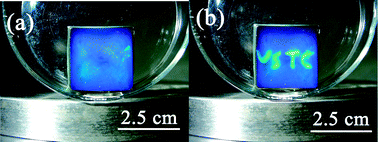Reusable photonic wordpad with water as ink prepared by radical polymerization†
Abstract
In this article, we report and demonstrate a novel photonic wordpad that is fabricated through the fast magnetically induced

* Corresponding authors
a
Hefei National Laboratory for Physical Sciences at Microscale and Department of Materials Science & Engineering, University of Science and Technology of China, Hefei, China
E-mail:
cqw@ustc.edu.cn
Fax: +81 551 3607251
Tel: +81 551 3607251
b Department of Materials of Science and Engineering, University of Science and Technology of China, Hefei, China
In this article, we report and demonstrate a novel photonic wordpad that is fabricated through the fast magnetically induced

 Please wait while we load your content...
Something went wrong. Try again?
Please wait while we load your content...
Something went wrong. Try again?
H. Hu, Q. Chen, H. Wang, R. Li and W. Zhong, J. Mater. Chem., 2011, 21, 13062 DOI: 10.1039/C1JM11697E
To request permission to reproduce material from this article, please go to the Copyright Clearance Center request page.
If you are an author contributing to an RSC publication, you do not need to request permission provided correct acknowledgement is given.
If you are the author of this article, you do not need to request permission to reproduce figures and diagrams provided correct acknowledgement is given. If you want to reproduce the whole article in a third-party publication (excluding your thesis/dissertation for which permission is not required) please go to the Copyright Clearance Center request page.
Read more about how to correctly acknowledge RSC content.
 Fetching data from CrossRef.
Fetching data from CrossRef.
This may take some time to load.
Loading related content
